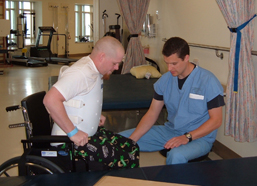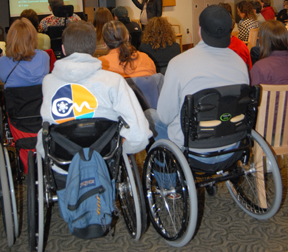Spinal Cord Injury Update
Fall 2008: Volume 17, Number 4
Literature Review
The articles previewed below were selected by the editors because they include potentially useful information on the diagnosis or management of spinal cord injury and its complications. How to obtain complete articles.
-
Outcomes
-
Pressure Ulcers
-
Bone health
-
Fatigue
-
Women with SCI
-
Treadmill training
-
Shoulder problems
-
Orthostatic Hypotension
Outcomes
Early complications of high-dose methylprednisolone in acute spinal cord injury patients.
This retrospective review of all patients admitted to the investigators’ ICU between January 1994 and December 2005 due to acute SCI compared those who received methylprednisolone (MP group, 59 patients) and those who did not (no-MP group, 23 patients). There were no differences between groups in ICU mortality or neurological function at ICU discharge. The MP group had more respiratory tract infections and total infections and a higher incidence of hyperglycemia than the no-MP group during the ICU stay. This study found that the use of MP in patients with acute SCI is not associated with improved outcome or neurological function at ICU discharge but is associated with an increased risk of infectious and metabolic complications during ICU stay.
Suberviola B, González-Castro A, Llorca J, et al.
Injury. 2008 Jul;39(7):748-52. Epub 2008 Jun 9.
Is age a key determinant of mortality and neurological outcome after acute traumatic spinal cord injury?
The authors examined a large, prospectively accrued clinical database (485 individuals) in addition to analysis of postmortem spinal cord tissue (12 individuals) to compare axonal survival and white matter degeneration in younger versus elderly individuals with SCI. Elderly individuals (age 65 and older) had significantly greater mortality rates than younger individuals 30 days, 6 months and at 1 year after SCI (46.88% versus 4.86%, respectively). However, age did not have a significant affect on motor and sensory recovery. Neuroanatomical analysis of postmortem spinal cord tissue revealed no significant age-related differences in extent of myelin degeneration or number of intact axons within sensory, motor and autonomic spinal cord tracts. Treatment protocols for SCI need to identify preventable predictors of mortality in the elderly post-SCI, recognizing that the potential for neurological recovery among elderly survivors of SCI is similar to that of younger individuals.
Furlan JC, Bracken MB, Fehlings MG.
Neurobiol Aging. 2008 Jun 10. [Epub ahead of print]
Pressure ulcers
Pressure ulcer prevention and management in spinal cord-injured adults: analysis of educational needs.
People with SCI have a high risk for pressure ulcers (PrUs) that increases with age and time since injury. The authors interviewed 16 adults with SCI concerning perception of PrU risk, education, environmental considerations, and access to care. Eight SCI professionals were also interviewed. Number of years since injury of participants ranged from less than one year to 33 years (median 18 years); 10 of the 16 participants had experienced having a PrU. Perception of risk varied: those with previous PrUs or who had a long rehab hospital stay were more likely to consider themselves at risk, whereas those who had never had a PrU perceived their risks as decreasing over time. Education needs identified include: Awareness of lifelong risk for developing PrUs, including the ability to assess own risk factors and how risk changes over time; ability to take charge of own skin care regimen and to partner with health care providers; perform prevention strategies consistently that fit level of functioning and activity and update practices as risk changes; ability to coordinate social supports. The need for effective education among adults with SCI in the prevention and early detection of PrUs is critical.
Schubart JR, Hilgart M, Lyder C.
Adv Skin Wound Care. 2008 Jul;21(7):322-9.
Remote monitoring of sitting behaviors for community-dwelling manual wheelchair users with spinal cord injury.
Twenty individuals with SCI (C4 – L2) who used manual wheelchairs for their primary mobility participated in this study. Average time in a wheelchair was 5.5 years. A custom data logger with six force sensor resistors was designed and installed on participants’ personal daily-use wheelchair seats. Sitting behaviors were recorded for 24 hours per day over a 1-week period. Participants spent an average of 9.2 hours (range 3.2–12.2 hours) per day in their own wheelchair. They sat for an average of 97 min (range 24–284 min) without displaying any lift-off (pressure relief) behavior. The average lift-off frequency was 9.4 times (range 2–20 times) per day. There was no difference between participants with paraplegia and those with tetraplegia. Education on the pressure relief activity should still be a core component for all manual wheelchair users regardless of neurological level.
Yang YS, Chang GL, Hsu MJ, Chang JJ.
Spinal Cord. 2008 Jun 17. [Epub ahead of print]
Bone health
Osteoporotic fractures and hospitalization risk in chronic spinal cord injury.
In a study population of 315 veterans with chronic SCI, 1,487 hospital admissions occurred; 39 (2.6%) of these were hospitalizations for bone fractures. Median length of stay was 35 days. Fracture-related complications occurred in 53% of these cases. Low-impact fractures were more common in motor complete SCI and associated with greater alcohol use after injury. Record review indicated that osteoporosis diagnosis and treatment considerations were not part of a clinical assessment, indicating the need for improved protocols that might prevent low-impact fractures and related admissions.
Morse LR, Battaglino RA, Stolzmann KL, et al.
Osteoporos Int. 2008 Jun 26. [Epub ahead of print]
Does standing protect bone density in patients with chronic spinal cord injury?
Seventy-one patients with chronic SCI were recruited and assigned to 1 of 3 groups according to their reported daily standing time: patients with daily standing times of more than 1 hour, patients with daily standing times of less than 1 hour, and nonstanding patients. The groups were similar in terms of demographics and clinical variables. Bone density of lumbar and proximal femoral regions was measured with dual-energy x-ray absorptiometry. Although the difference between groups was not significant, patients in the group that stood more than 1 hour daily had a slight tendency to have slightly higher bone density in the lumbar and proximal femoral regions, leading the authors to conclude that standing might be partially helpful in protecting the bone density in SCI by opposing the effects of immobilization.
Goktepe AS, Tugcu I, Yilmaz B, et al.
J Spinal Cord Med. 2008;31(2):197-201.
Fatigue
Fatigue and spinal cord injury: a qualitative analysis.
To explore experiences of fatigue among people with SCI, four focus groups were conducted with a total of 29 participants, including: 21 people with complete and incomplete SCI with tetraplegia and paraplegia, two family members, two assistants and four occupational therapists. Results showed that fatigue has cognitive, emotional and physical dimensions and exerts a profound effect on the lives of many people with SCI, such that pleasurable activities were often missed in order to accomplish more mundane tasks. Factors most consistently associated with fatigue were pain, depression and hopelessness, side effects of medications, poor quality sleep, spasticity, poor posture, diet, and the effort required to accomplish routine and self-care tasks.
Hammell KW, Miller WC, Forwell SJ, et al.
Spinal Cord. 2008 Jun 10. [Epub ahead of print]
Women with SCI
Women living with a spinal cord injury: perceptions about their changed bodies.
This study collected information from 15 women (ages 18 to 60, both quadriplegia and paraplegia) through structured interviews on social adaptation three or more years after injury. A three-phase process of living with their changed bodies emerged: 1) discomfort or uneasiness related to one’s own body; 2) moving toward comfort, employing strategies progressing form social isolation to representing themselves in a positive light through appearance and behavior; and 3) comfort, achieved by educating others about visible disabilities and surrounding oneself with an accepting environment. Physical therapy can potentially influence the process of women’s gaining comfort with their changed bodies following an SCI.
Chau L, Hegedus L, M, et al.
Qual Health Res. 2008 Feb;18(2):209-21.
Treadmill training
Automating activity-based interventions: The role of robotics.
Studies have found that interventions such a robotic-assisted body weight supported treadmill training can improve gate in SCI, but few studies have investigated the use of these devices in improving the overall health and well-being. The authors discuss the use of robotic devices in delivering intense, activity-based therapies that may have significant exercise benefits. They also present preliminary data from studies that investigated the metabolic and cardiac responses during and after 6 months of lower-limb robotic training. Advantages of using robotic devices instead of therapists include the capacity for longer training periods, at higher intensities and in a well-controlled environment. Therapists engaged in treadmill training with patients have reported repetitive strain injuries and lower back problems. However, robotics are very expensive and not usually able to a subject’s effort level, spasticity or fatigue. Future models must have better monitoring and interactive capabilities, and future studies should monitor cardiac and metabolic responses.
Hidler J, Hamm LF, Lichy A, Groah SL.
J Rehabil Res Dev. 2008;45(2):337-44.
Shoulder problems
Comparative shoulder kinematics during free standing, standing depression lifts and daily functional activities in persons with paraplegia: considerations for shoulder health.
In three female and two male subjects at least 12 months post-SCI, a magnetic tracking device was used to measure three-dimensional positions of the scapula, humerus and thorax (shoulder joint) during common upper extremity weight-bearing activities (standing depression lifts used in brace walking, weight-relief raises, transfers) and postures (sitting rest, standing in a frame). Standing in a frame offered the best shoulder joint positions (significantly less scapular anterior tilt and greater glenohumeral external rotation) when compared to sitting rest posture, weight-relief raises, transfers and standing depression lifts. Choosing specific activities or modifying techniques within functional activities that promote favorable shoulder positions may preserve long-term shoulder health.
Riek LM, Ludewig PM, Nawoczenski DA.
Spinal Cord. 2008 May;46(5):335-43. Epub 2007 Nov 20.
Orthostatic hypotension
Non-pharmacological management of orthostatic hypotension after spinal cord injury: a critical review of the literature.
Orthostatic hypotension (OH; a sudden fall in blood pressure that occurs when a person assumes an upright position, such as going from lying to sitting) is a common problem in SCI that can delay rehabilitation progress. More than half of all SCI patients will develop OH within the first month after injury. Symptoms of OH (fatigue, weakness, light headedness, dizziness, blurred vision and neck pain) may be present in as many as 73.6% of all physical therapy treatments during early rehabilitation. In this systematic review of the literature, four distinct non-pharmacological interventions for OH were identified: application of compression and pressure to the abdominal region and/or legs, upper body exercise, functional electrical stimulation (FES) applied to the legs and biofeedback. Methodological quality varied dramatically between studies. Compression/pressure, upper body exercise and biofeedback therapies have proven inconclusive in their ability to control OH. During orthostatic challenge, FES consistently lessens the fall in BP; however, its clinical application is less well established. The clinical usefulness of compression/pressure, upper body exercise and biofeedback for treating OH has not been proven. FES of the legs holds the most promise.
Gillis DJ, Wouda M, Hjeltnes N.
Spinal Cord. 2008 Jun 10. [Epub ahead of print]
How to obtain the complete articles
You may obtain copies of the complete articles through your local medical library or through the University of Washington Health Sciences Library Document Service at 206-543-3441 or http://healthlinks.washington.edu/hsl/docservices/illiad.htm. (There is a fee for this service.)






